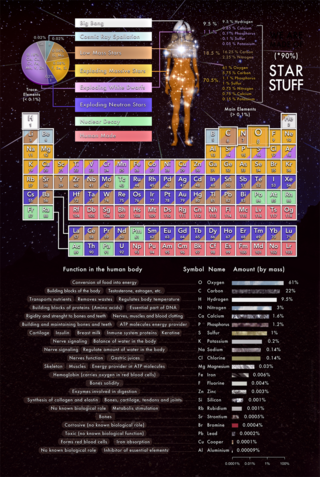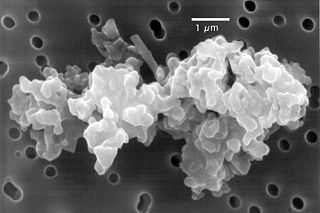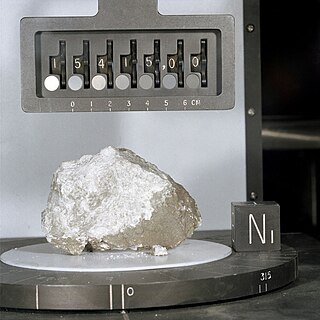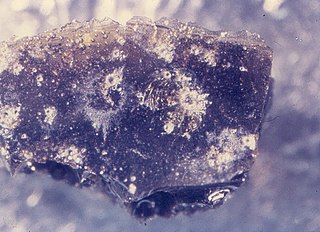
Astrobiology is a scientific field within the life and environmental sciences that studies the origins, early evolution, distribution, and future of life in the universe by investigating its deterministic conditions and contingent events. As a discipline, astrobiology is founded on the premise that life may exist beyond Earth.

Panspermia is the hypothesis that life exists throughout the Universe, distributed by space dust, meteoroids, asteroids, comets, and planetoids, as well as by spacecraft carrying unintended contamination by microorganisms. Panspermia is a fringe theory with little support amongst mainstream scientists. Critics argue that it does not answer the question of the origin of life but merely places it on another celestial body. It is also criticized because it cannot be tested experimentally.

Astrochemistry is the study of the abundance and reactions of molecules in the universe, and their interaction with radiation. The discipline is an overlap of astronomy and chemistry. The word "astrochemistry" may be applied to both the Solar System and the interstellar medium. The study of the abundance of elements and isotope ratios in Solar System objects, such as meteorites, is also called cosmochemistry, while the study of interstellar atoms and molecules and their interaction with radiation is sometimes called molecular astrophysics. The formation, atomic and chemical composition, evolution and fate of molecular gas clouds is of special interest, because it is from these clouds that solar systems form.

Stardust was a 385-kilogram robotic space probe launched by NASA on 7 February 1999. Its primary mission was to collect dust samples from the coma of comet Wild 2, as well as samples of cosmic dust, and return them to Earth for analysis. It was the first sample return mission of its kind. En route to Comet Wild 2, it also flew by and studied the asteroid 5535 Annefrank. The primary mission was successfully completed on 15 January 2006 when the sample return capsule returned to Earth.

Cosmochemistry or chemical cosmology is the study of the chemical composition of matter in the universe and the processes that led to those compositions. This is done primarily through the study of the chemical composition of meteorites and other physical samples. Given that the asteroid parent bodies of meteorites were some of the first solid material to condense from the early solar nebula, cosmochemists are generally, but not exclusively, concerned with the objects contained within the Solar System.

A micrometeorite is a micrometeoroid that has survived entry through the Earth's atmosphere. Usually found on Earth's surface, micrometeorites differ from meteorites in that they are smaller in size, more abundant, and different in composition. The IAU officially defines meteorites as 30 micrometers to 1 meter; micrometeorites are the small end of the range (~submillimeter). They are a subset of cosmic dust, which also includes the smaller interplanetary dust particles (IDPs).

Cosmic dust – also called extraterrestrial dust, space dust, or star dust – is dust that occurs in outer space or has fallen onto Earth. Most cosmic dust particles measure between a few molecules and 0.1 mm (100 μm), such as micrometeoroids. Larger particles are called meteoroids. Cosmic dust can be further distinguished by its astronomical location: intergalactic dust, interstellar dust, interplanetary dust, and circumplanetary dust. There are several methods to obtain space dust measurement.
The interplanetary dust cloud, or zodiacal cloud, consists of cosmic dust that pervades the space between planets within planetary systems, such as the Solar System. This system of particles has been studied for many years in order to understand its nature, origin, and relationship to larger bodies. There are several methods to obtain space dust measurement.

A sample-return mission is a spacecraft mission to collect and return samples from an extraterrestrial location to Earth for analysis. Sample-return missions may bring back merely atoms and molecules or a deposit of complex compounds such as loose material and rocks. These samples may be obtained in a number of ways, such as soil and rock excavation or a collector array used for capturing particles of solar wind or cometary debris. Nonetheless, concerns have been raised that the return of such samples to planet Earth may endanger Earth itself.

David Stewart McKay was chief scientist for astrobiology at the Johnson Space Center. During the Apollo program, McKay provided geology training to the first men to walk on the Moon in the late 1960s. McKay was the first author of a scientific paper postulating past life on Mars on the basis of evidence in Martian meteorite ALH 84001, which had been found in Antarctica. This paper has become one of the most heavily cited papers in planetary science. The NASA Astrobiology Institute was founded partially as a result of community interest in this paper and related topics. He was a native of Titusville, Pennsylvania.
CI chondrites, also called C1 chondrites or Ivuna-type carbonaceous chondrites, are a group of rare carbonaceous chondrite, a type of stony meteorite. They are named after the Ivuna meteorite, the type specimen. CI chondrites have been recovered in France, Canada, India, and Tanzania. Their overall chemical composition closely resembles the elemental composition of the Sun, more so than any other type of meteorite.
Interplanetary contamination refers to biological contamination of a planetary body by a space probe or spacecraft, either deliberate or unintentional.

A planetary surface is where the solid or liquid material of certain types of astronomical objects contacts the atmosphere or outer space. Planetary surfaces are found on solid objects of planetary mass, including terrestrial planets, dwarf planets, natural satellites, planetesimals and many other small Solar System bodies (SSSBs). The study of planetary surfaces is a field of planetary geology known as surface geology, but also a focus on a number of fields including planetary cartography, topography, geomorphology, atmospheric sciences, and astronomy. Land is the term given to non-liquid planetary surfaces. The term landing is used to describe the collision of an object with a planetary surface and is usually at a velocity in which the object can remain intact and remain attached.
Comparative planetary science or comparative planetology is a branch of space science and planetary science in which different natural processes and systems are studied by their effects and phenomena on and between multiple bodies. The planetary processes in question include geology, hydrology, atmospheric physics, and interactions such as impact cratering, space weathering, and magnetospheric physics in the solar wind, and possibly biology, via astrobiology.

The Tanpopo mission is an orbital astrobiology experiment investigating the potential interplanetary transfer of life, organic compounds, and possible terrestrial particles in the low Earth orbit. The purpose is to assess the panspermia hypothesis and the possibility of natural interplanetary transport of microbial life as well as prebiotic organic compounds.

The curation of extraterrestrial samples (astromaterials) obtained by sample-return missions takes place at facilities specially designed to preserve both the sample integrity and protect the Earth. Astromaterials are classified as either non-restricted or restricted, depending on the nature of the Solar System body. Non-restricted samples include the Moon, asteroids, comets, solar particles and space dust. Restricted bodies include planets or moons suspected to have either past or present habitable environments to microscopic life, and therefore must be treated as extremely biohazardous.
Asteroidal water is water or water precursor deposits such as hydroxide (OH−) that exist in asteroids. The "snow line" of the Solar System lies outside of the main asteroid belt, and the majority of water is expected in minor planets. Nevertheless, a significant amount of water is also found inside the snow line, including in near-earth objects (NEOs).
Pseudo-panspermia is a well-supported hypothesis for a stage in the origin of life. The theory first asserts that many of the small organic molecules used for life originated in space. It continues that these organic molecules were distributed to planetary surfaces, where life then emerged on Earth and perhaps on other planets. Pseudo-panspermia differs from the fringe theory of panspermia, which asserts that life arrived on Earth from distant planets.

Space dust measurement refers to the study of small particles of extraterrestrial material, known as micrometeoroids or interplanetary dust particles (IDPs), that are present in the Solar System. These particles are typically of micrometer to sub-millimeter size and are composed of a variety of materials including silicates, metals, and carbon compounds. The study of space dust is important as it provides insight into the composition and evolution of the Solar System, as well as the potential hazards posed by these particles to spacecraft and other space-borne assets. The measurement of space dust requires the use of advanced scientific techniques such as secondary ion mass spectrometry (SIMS), optical and atomic force microscopy (AFM), and laser-induced breakdown spectroscopy (LIBS) to accurately characterize the physical and chemical properties of these particles.

Dust astronomy is a subfield of astronomy that uses the information contained in individual cosmic dust particles ranging from their dynamical state to its isotopic, elemental, molecular, and mineralogical composition in order to obtain information on the astronomical objects occurring in outer space. Dust astronomy overlaps with the fields of Planetary science, Cosmochemistry, and Astrobiology.
















